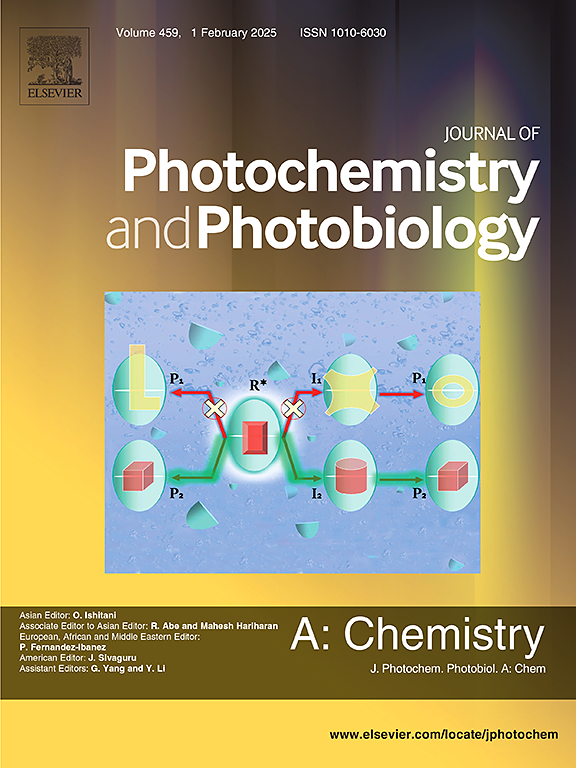The photoelectrochromic performance of a Nb-doped TiO2 colloid in DMF
IF 4.1
3区 化学
Q2 CHEMISTRY, PHYSICAL
Journal of Photochemistry and Photobiology A-chemistry
Pub Date : 2025-03-31
DOI:10.1016/j.jphotochem.2025.116406
引用次数: 0
Abstract
Effective systems controlling light transmittance are essential for energy management regarding reduced energy consumption and for providing on-demand switchable privacy functions in buildings. Here, we report a photoelectrochromic device based on Nb-doped TiO2 nanoparticles in N,N-dimethylformamide (DMF) sandwiched between two ITO-coated glass panes. Nb-doped TiO2 nanoparticles allow selective control of the light absorption in the IR spectral range, leaving the visible range less affected. Upon irradiation under open circuit (OC) conditions, the transmittance change in the visible wavelength range of 400–700 nm was 59.0 ± 4.1 %, whereas, in the near-infrared wavelength range of 700–950 nm, it was 80.0 ± 2.9 % within 3 min of irradiation. This was achieved by irradiating the sample with UVA (365 nm) light. The recovery rate of photo-irradiated colloids can be modulated by applying an alternating electrical voltage. This allows for an increase in the recovery rate by several orders of magnitude.

纳米掺杂TiO2胶体在DMF中的光电致变色性能
有效的控制透光率的系统对于降低能源消耗和在建筑物中提供按需切换的隐私功能的能源管理至关重要。在这里,我们报道了一种基于nb掺杂TiO2纳米颗粒的光电致变色器件,该器件位于N,N-二甲基甲酰胺(DMF)中,夹在两片ito涂覆的玻璃板之间。铌掺杂TiO2纳米颗粒可以选择性地控制红外光谱范围内的光吸收,使可见光范围受到较小的影响。在开路辐照条件下,400 ~ 700 nm的可见光透射率变化为59.0±4.1%,700 ~ 950 nm的近红外透射率在辐照3 min内变化为80.0±2.9%。这是通过UVA (365 nm)光照射样品实现的。光照射胶体的回收率可以通过施加交变电压来调节。这可以使回收率提高几个数量级。
本文章由计算机程序翻译,如有差异,请以英文原文为准。
求助全文
约1分钟内获得全文
求助全文
来源期刊
CiteScore
7.90
自引率
7.00%
发文量
580
审稿时长
48 days
期刊介绍:
JPPA publishes the results of fundamental studies on all aspects of chemical phenomena induced by interactions between light and molecules/matter of all kinds.
All systems capable of being described at the molecular or integrated multimolecular level are appropriate for the journal. This includes all molecular chemical species as well as biomolecular, supramolecular, polymer and other macromolecular systems, as well as solid state photochemistry. In addition, the journal publishes studies of semiconductor and other photoactive organic and inorganic materials, photocatalysis (organic, inorganic, supramolecular and superconductor).
The scope includes condensed and gas phase photochemistry, as well as synchrotron radiation chemistry. A broad range of processes and techniques in photochemistry are covered such as light induced energy, electron and proton transfer; nonlinear photochemical behavior; mechanistic investigation of photochemical reactions and identification of the products of photochemical reactions; quantum yield determinations and measurements of rate constants for primary and secondary photochemical processes; steady-state and time-resolved emission, ultrafast spectroscopic methods, single molecule spectroscopy, time resolved X-ray diffraction, luminescence microscopy, and scattering spectroscopy applied to photochemistry. Papers in emerging and applied areas such as luminescent sensors, electroluminescence, solar energy conversion, atmospheric photochemistry, environmental remediation, and related photocatalytic chemistry are also welcome.

 求助内容:
求助内容: 应助结果提醒方式:
应助结果提醒方式:


